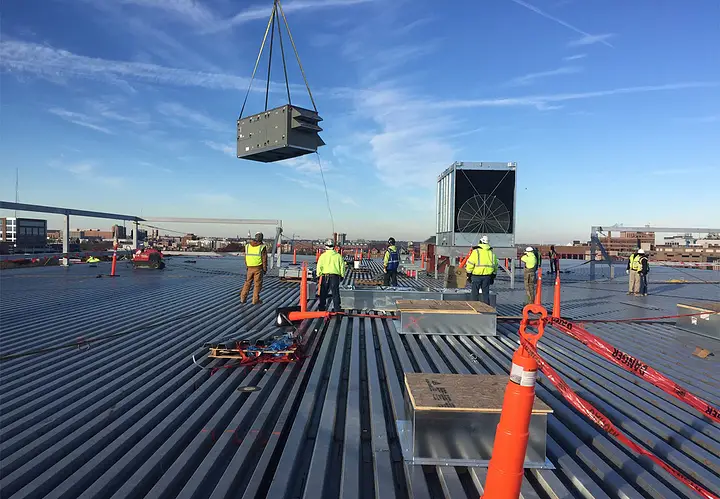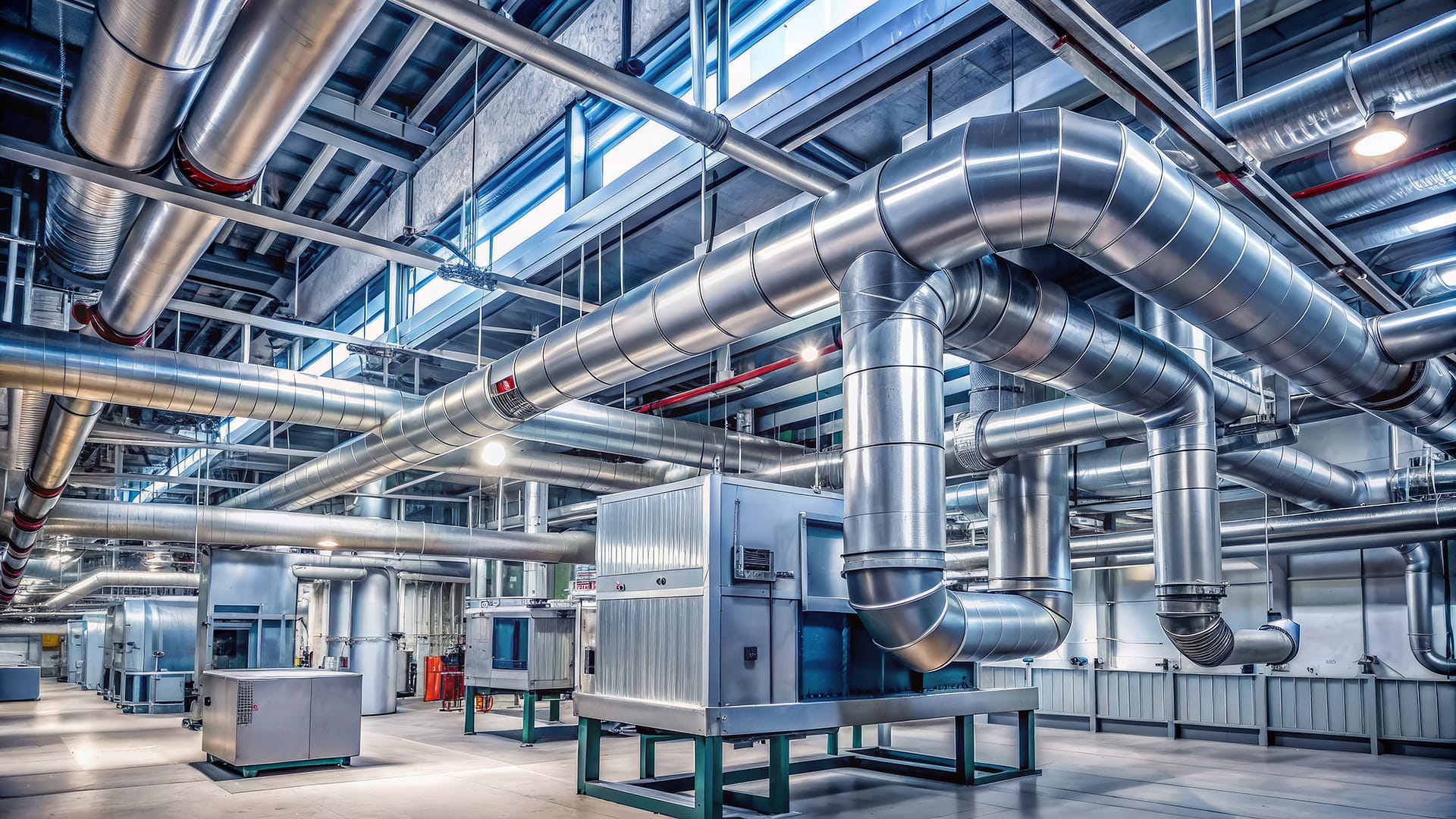Table of Contents:
1. Introduction: Why Scaling an HVAC Business is a Unique Challenge
2. Laying the Foundation for Growth
3. Streamlining Operations for Efficiency and Profitability
4. Diversifying Services to Drive Recurring Revenue
5. Sales and Marketing Strategies to Reach High-Value Clients
6. Leveraging Technology and Data for Informed Decision-Making
7. Building and Retaining a Skilled Workforce
8. Financial Planning and Scaling for Long-Term Success
9. Building Partnerships and Expanding Networks
10. Building a Company Culture that Attracts and Retains Top Talent
11. Real-Life Success Stories and Case Studies
12. Growing Through Strategic Acquisitions
13. Conclusion: Your Roadmap to Sustainable Multi-Million-Dollar Growth
14. FAQ Section
Introduction: Why Scaling an HVAC Business is a Unique Challenge

Imagine a commercial HVAC business overflowing with loyal customers, a full sales pipeline for the next several quarters, a highly skilled team of talented professionals running the day-to-day operations, and a well-known brand for delivering excellent service.
Unfortunately, imagining this is far easier than building it. The truth is—everyone is trying to build this type of business. Whether you’re just getting started, growing from $1- 10 Million, $20- 100 Million, or more—hard work alone isn’t going to get you to the next level.
Consistent growth is about choosing a better vehicle to get you to your goal. To illustrate, consider the differences between a race car and a work truck. The race car will get you around a track quickly, but it can’t tow a large trailer, haul equipment, or get your crew to a job site. Similarly, a work truck can do all of those things, but it’s not built for speed.
In the same way, growing your HVAC business requires a different approach than simply working harder.
It’s about building a great culture, implementing the right systems, focusing on customer acquisition, service diversification, financial planning, leveraging the right technology, and building a solid foundation that supports consistent growth over the long term.
In this comprehensive guide, we’ll explore proven strategies for growing a commercial HVAC business into a multi-million-dollar operation. We’ll cover everything from laying a solid foundation to looking for other HVAC businesses to acquire.
This is not a short article, so if you’re in a time crunch, feel free to bookmark it and come back to it when you have a challenge you’d like ideas to overcome.
Laying the Foundation for Growth

The first principle of “revenue acceleration” is alignment towards growth. This means your leadership team, sales and marketing goals, tools and systems, customer profiles, installations, service and maintenance, and customer satisfaction are all aligned and moving in the same direction.
Strategic alignment begins with clear and measurable goal setting, creating a team culture around how you want people to feel when they see your logo, and defining an ideal customer profile (ICP) that can scale with your business as it grows.
Without clear and measurable goals, it’s hard to communicate where you’re going to your team. It’s also easy to get lost in the day-to-day operations of your business and forget what matters most for the benefit of your customers and the long-term success of your business.
Maintaining focus requires you to not only set both quarterly and annual goals for revenue, customer acquisition, tools, and operational improvements, but also to communicate them to your entire organization so your whole company is moving in a direction together.
Next, growth accelerates when you begin targeting the right customers. For businesses focused on HVAC, high-value customers often include titles like; “facilities directors,” “property managers,” and “owners” of commercial properties and businesses.
Targeting the right potential clients allows you to segment your market, find the right tools and marketing channels to reach them most effectively, and tailor your sales and marketing messaging to meet their most pressing needs.
While developing an ICP might sound complex, it’s actually very simple. Think about the best customer you’ve ever worked with. The one who paid on time was easy to work with and referred you to other great customers. What were their traits? What industry were they in? How many employees do they have? Answering these questions will help you define your ICP.

For example, a great “avatar” could be Jeff Smith, Facilities Director at XYZ Senior Living Communities. Jeff has 15 years of experience in facility management and is responsible for maintaining multiple properties. He values timely service, clear communication, and expert advice from his HVAC providers.
With this avatar in mind, you can easily identify all of the senior living communities and facilities in your service areas and focus on this segment of the market. Doing this will “arm” you with tailored messaging, challenges, and solutions that will resonate with Jeff, making it easier to convert him into a loyal customer.
Finally, establishing a solid foundation for growth requires investing in the right tools and systems. This means putting a “tech stack” of tools in place to help your team streamline every step from customer acquisition to service and contract management.
Some primary tools could be prospecting and lead generation platforms, sales pipeline management and customer relationship management (CRM) tools, sales tracking and analytics software, dispatch solutions, and field team or project management software.
These tools not only help streamline operations but also provide valuable insights that can inform decision-making for future growth opportunities.
Building a Company Culture that Attracts and Retains Top Talent

Building and retaining a skilled workforce takes a lot of work—in fact it might be the most difficult part of your job. The reason for this is; people follow people—Meaning leadership should be engaging, focused on the mission, firm about what matters, and flexible about what doesn’t.
The challenge is deciding what matters and what doesn’t
Integrity, character, and a strong work ethic are key ingredients for success in any business, but they are especially necessary in the HVAC industry—where skilled technicians are in high demand, salespeople rarely stay long-term, and workforce shortages seem to plague the industry.
A strong and rewarding culture not only attracts top talent but also enhances morale, boosts productivity, and improves employee retention. People today want more than a job. They want to matter, to see how they fit into the whole picture, and to be encouraged to pursue a version of themselves that they couldn’t achieve without your leadership and vision.
Here’s how to build a company culture that supports your team and drives long-term growth:
Define Your Core Values and Company Mission

A clear mission and core values are the cornerstone of an attractive culture. But these must be deeper than words on a website for new recruits to memorize.
Whether it’s a commitment to customer satisfaction, safety, or environmental responsibility, make sure your values are lived out in your business from the top down. Ensure that they’re known, well-defined, and communicated across the entire company.
When your team feels connected to a bigger purpose, they’re more likely to be flexible as the market changes, engaged in helping you achieve set goals, and motivated by the progress they’re able to help you create.
Promote Continuous Learning and Development

Employees also like to feel that they’re “going somewhere.” Their job isn’t just a paycheck but actually elevating their potential to make money and build a career.
This means offering training programs and skill development opportunities that show employees you’re invested in their growth.
Whether it’s sales training, advanced HVAC certifications, customer service training, or safety refreshers (which let’s be honest, none of us enjoy- but are required to stay injury free and off OSHA’s radar), continuous learning not only improves skills but also keeps your team engaged.
When employees feel like they’re winning, the temptation to leave for “greener pastures” is less of a factor. I think it’s fair to say that sales people who consistently meet or exceed quarterly goals and technicians who feel supported in their career progression are more likely to stay with the company long-term.
This also lowers recruitment costs and downtime for onboarding and ramping up new employees.
Encourage Open Communication and Feedback

Open communication and feedback are tough. It’s hard for anyone to hear that they can do better. But a culture of open communication and thoughtful feedback helps foster trust and accountability.
Regular check-ins, team meetings, and feedback channels make employees feel heard and valued (if you listen to them). Encourage team members to go through the proper channels to voice ideas, address concerns, and publicly celebrate wins together.
Foster Work-Life Balance and Flexibility

One of the hardest challenges you will face with recruitment is knowing which team members are using “work-life balance” as an excuse (to get out of work) and which ones are top performers using work-life balance to rest, take care of their families, and perform at their best.
HVAC work can be demanding, and a supportive culture recognizes the importance of work-life balance while removing toxic people who bring down team morale through laziness and escapism.
Consider offering benefits that will reinforce performance and reward great work. Holidays, flexible scheduling, paid time off, and fair distribution of on-call shifts are just a couple of ways that you can do this.
These small adjustments can significantly boost employee satisfaction and loyalty.
Recognize and Reward Performance

People love to be celebrated—whether it’s a bonus, an “Employee of the Month” program, or simple shoutouts at team meetings—help reinforce a culture of appreciation. Performance bonuses, recognition from leaders, and unique opportunities for those who earn them can be a great way to incentivize high-performers without having to come out-of-pocket.
Acknowledging hard work and positive outcomes encourages employees to stay motivated and committed to the company’s growth.
In any case, HVAC is hyper-competitive. Building a strong, supportive culture is just as important as the systems you use or the sales and marketing strategies you choose. A positive work environment keeps your team happy, loyal, and productive—key ingredients for scaling a successful, multi-million-dollar business.
Streamlining Operations for Efficiency and Profitability

When it comes to operational tasks like managing inventory, equipment, customer data, emergencies, installations, service, maintenance, repairs, and field team management, things can really go off the rails if they’re not well managed.
Here are four examples of tasks that take time, waste resources, and can easily be replaced with tools that automate and streamline key roles:
1. Prospecting and Lead Generation: Arguably, the most important task in any business is finding prospects and generating leads. Without an efficient sales engine, your business may grow, but it won’t be consistent or sustainable. Platforms like Convex allow you to find qualified prospects based on your ICP and send personalized outreach messages to them in 3- 5 minutes per account.
2. Optimizing Field Service and Dispatch: Efficient operations are the backbone of a growing HVAC business. Field service management software allows you to automate scheduling, dispatch, and route optimization, saving time and reducing costs. With the right tools, technicians spend less time traveling and more time servicing clients, boosting productivity and customer satisfaction.
3. Building a Reliable CRM System: A CRM system helps manage customer relationships by tracking equipment data, contracts, service history, preferences, and maintenance schedules. This enables your team to deliver personalized service, which increases retention rates and encourages referrals. Look for a CRM that integrates with HVAC-specific needs like prospecting, lead generation, recurring maintenance tracking, install base mapping, and more.
4. Implementing Automation for Day-to-Day Tasks: Today’s tools are so much better than even 18 months ago. Automation tools for invoicing and billing, reminders, and follow-ups can reduce administrative tasks and keep customers engaged without added effort.
These small changes can significantly improve workflow efficiency and free up resources for other growth-focused activities that require a human touch!
8 Ways to Generate Sales: Growing Revenue by Offering Various Value-added Services
For a commercial HVAC company, offering a mix of one-time and ongoing services can make a big difference in growing revenue. Having a range of services helps keep cash flow steady and lets you meet more of your clients’ needs. Here are some ideas for how to set up your offerings:

1. Designing and Installing HVAC and Mechanical Systems
Designing and installing new HVAC systems or upgrading old ones can bring in a lot of income all at once.
Big projects often lead to other opportunities, like regular maintenance plans and service agreements, to keep downtime to a minimum, clients happy, and systems running well.
2. Maintenance Contracts and Service Plans
Offering regular maintenance is a great way to create a steady income that provides cash flow to break “seasonal slumps.” Contracts can be set up for annual, semi-annual, or quarterly check-ups.
Maintenance plans and service agreements help clients avoid costly repairs and ensure HVAC systems are working smoothly year-round. In commercial buildings, dependable service can be a big reason tenants decide to stay, making these contracts a smart choice for property managers and building owners looking for long-term lease agreements.

3. Providing Energy Audits and Green Solutions
With more companies looking to save energy and meet green standards, energy audits, and eco-friendly HVAC upgrades are in demand.
The initial audit and equipment upgrades are usually one-time services, but they can lead to follow-up audits or ongoing maintenance which adds recurring revenue opportunities to your books.
These services also give your company a chance to stand out by promoting energy savings and green building solutions.
4. Indoor Air Quality (IAQ) Services
Like Green solutions, with growing attention to health, indoor air quality is a hot topic. Installing IAQ systems, like air filters and purifiers, usually starts as a one-time job, but they often need regular checks and maintenance to stay effective.
Adding these services will not only help clients improve their air quality but also gain a recurring revenue stream for your business—especially from places like hospitals and schools that need to meet strict health standards.

5. Controls and Automation Systems
Advanced building management systems (BMS) and smart controls let clients monitor and adjust HVAC settings remotely, saving energy and money.
The setup of these systems will bring in additional one-time income, while regular service or monitoring can provide ongoing revenue. Many clients may also appreciate bundling this service with their HVAC maintenance plans, creating more value and customer loyalty—and loyalty always pays dividends.
6. Emergency Repairs and Priority Service
When systems break down, clients often need urgent help, and they’re willing to pay more for quick service. Offering emergency repairs at premium rates can be a profitable option.
Consider creating a “priority service” package so high-stakes clients can get help faster. These premium services show clients you’re dedicated to quick, quality support.

7. Specialized HVAC Services for Certain Industries
Facilities like data centers (which are a huge opportunity right now with the rise of AI), cell phone tower substations, labs, food and pharmaceutical manufacturing, blending facilities, and hospitals often need unique HVAC setups for precise temperature control.
Many of these types of facilities require frequent monitoring to make sure systems stay stable which you can offer as a recurring service. Working with specialty industries like these opens up big projects and the chance to provide ongoing service.
8. Equipment Leasing and Long-Term Rentals
Leasing or renting HVAC equipment can provide long-term income and give clients a way to access large HVAC setups without the upfront costs.
Many manufacturing facilities, construction sites, event venues, and military and government installations rent or lease HVAC equipment for temporary use. These leases generally include service and maintenance as part of the deal, creating another source of steady income for your business.
Offering a mix of one-time and recurring services helps keep revenue balanced. One-time projects, like installations and repairs, bring in quick cash, while maintenance contracts and premium service plans provide a reliable income month-to-month. This approach gives your business a strong foundation for growth and helps build trust with clients.
4 Sales and Marketing Strategies to Reach High-Value Clients

Outbound Sales Engine that Finds Prospects and Drives Deals
One of the most predictable and powerful tools for B2B businesses is building an effective outbound sales engine. An outbound sales engine relies on the right tools for identifying, connecting with, and converting high-value prospects into sales. This process involves a series of steps that include prospecting, lead generation, nurturing, and conversion.
Here are some tips for creating an effective outbound sales engine:
1. Define Your Ideal Customer Profile (ICP): Before you can start reaching out to potential clients, you need to know exactly who they are. Define your ideal customer based on factors such as industry, company size, location, and pain points. Use the profile in the second section as a guide for targeting the right people.
2. Invest in the Right Prospecting Tools: There are many tools available that can help you identify and connect with your ICP—but not all of them are “created equal.” Some popular options include Convex and LinkedIn Sales Navigator, but there are also helpful databases like Hunter and Apollo. Whichever one you choose, make sure that it’s the best solution for your ICP, gives you the best quality information, and fits your budget.
3. Create Compelling Outreach Messages: When reaching out to potential clients, make sure your message is personalized, relevant, and valuable to them. This is where Convex separates itself from the competition. Convex uses a combination of property data, sales intelligence, and buying signals to show you which prospects are “in-market” and actively searching for your services—giving you an immediate edge when reaching out.
4. Use a Multichannel Approach: Don’t rely on just one channel for outreach—combine them for greater effect. Utilize email, phone calls, social media, and direct mail to reach prospects and increase your chances of connecting with them.
5. Nurture Leads Through Email Campaigns: Not every prospect will be ready to buy right away. Use email campaigns as a way to stay top-of-mind with leads. Share industry insights, success stories, and any new services or offers you have
Using Paid Ads and Retargeting for Lead Generation

Google Local Service Ads (LSA) and pay-per-click (PPC) ads allow you to show up on the top of results and target HVAC keywords that can generate highly qualified leads.
Retargeting campaigns can also keep your brand top-of-mind for clients who may not be ready to engage immediately but are potential clients down the line.
Building an Online Presence

Local SEO is critical for HVAC businesses, particularly in commercial markets. Optimize your website for local traffic. Make sure your Google My Business profile is working. Encourage customer reviews and create a blog featuring HVAC maintenance tips and energy-saving advice. All of these will boost your online visibility and position your business as an industry expert.
Note that building an online presence is a long-term strategy, and you’ll rarely get results this quarter. But, you know what they say, “The best time to plant a tree was 20 years ago; the second best time is today.”
Building an online presence will help you generate leads over the lifetime of your business, so take a long-term perspective on how you build it.
Effective Social Media and Multi-Channel Engagement for Commercial HVAC

LinkedIn is a powerful platform for reaching facilities managers, property owners, and other commercial clients. As the largest professional network, it’s an ideal place to share industry insights, success stories, testimonials, and company updates to engage potential clients. However, LinkedIn isn’t the only channel that can boost your reach.
X (formerly Twitter), Instagram, and TikTok also offer ways to share helpful tips, industry updates, and success stories. These platforms let you connect with a broader audience, increase visibility, and even improve your site’s domain authority (DA) through quality backlinks.
People today spend more time on their phones than any other device, opening up big opportunities for outreach.
With two clicks, Convex’s Generative AI can create a personalized email or phone script as your initial outreach. If the prospect doesn’t reply immediately (which they often don’t), you can later turn this script into a short Loom video to create a stronger connection and “put a face to a name.”
Balancing these channels means staying relevant. People on Instagram may be there for entertainment, while those on LinkedIn are looking for valuable contacts and industry information.
Keep in mind that with a multichannel approach, you have to adjust your messaging to each platform, or you’ll end up “burning out” your audience.
Leveraging Technology and Data for Informed Decision-Making

In sales, timing is everything. If you’re not first, competitors can sneak in and steal opportunities that may’ve been perfect for your business. Today’s tools allow you to accelerate revenue through data-driven insights.
Here are three solutions to help you accelerate sales without adding additional burden to your team:
1. Utilizing Property Intelligence Tools: Tools like Convex’s Atlas combine sales intelligence, buying signals, data on property ownership, permit history, and contact details, making it easier to target decision-makers. This solution is your go-to platform for prospecting and generating leads. Convex gives your team valuable insights to see their entire territory on a map and zero in on properties that match your ideal customer profile based on buying signals and other relevant details. Plus, with built-in Generative AI, you can create personalized outreach emails and phone scripts in just 3 to 5 minutes! This is a game-changer for any team prospecting commercial properties.
2. Tracking Metrics to Enhance Sales Efforts: Monitoring metrics like customer lifetime value (CLV), conversion rates, and lead velocity helps identify where to focus marketing efforts and which clients bring the most value. With these insights, your team can tailor outreach, improve upselling, and optimize retention strategies.
3. Adopting HVAC-Specific Software Solutions: Use software designed for HVAC operations to streamline everything from scheduling to customer management. These solutions help eliminate inefficiencies and enable your team to respond quickly to customer needs, driving overall customer satisfaction.
Financial Planning and Scaling for Long-Term Success

Financial management is the difference between commercial HVAC businesses that stand the test of time and those that fail after only a few seasons. To maintain long-term success, consider these strategies:
1. Developing a Business Plan: A well-crafted business plan sets the tone for how your company operates, where it’s going, and how it will get there. It should include goals, target market analysis, financial projections, and marketing strategies.
2. Smart Financial Management Practices: Regularly reviewing budgets, cash flow, and profit margins is essential for scaling. Establish a financial dashboard that tracks key metrics so you can spot trends, address issues early, and make data-driven decisions.
3. Strategic Pricing Models: Flat-rate and value-based pricing models can enhance profit margins. Value-based pricing works especially well for commercial clients willing to pay more for reliable, high-quality service.
4. Diversifying Revenue Sources: Don’t rely solely on one type of service or client base for revenue. Explore opportunities to diversify your offerings. Make sure to combine one-time and recurring revenue sources to overcome seasonality and set your business up for long-term sustainable growth.
5. Creating a Scalable Model: Growth should be planned carefully. Expanding operations, whether by hiring additional staff, adding locations, or launching new services, requires a strategy. Make sure each expansion effort aligns with long-term goals and builds on your existing strengths.
Building Partnerships and Expanding Networks

Strategic partnerships can be a powerful way to grow your HVAC business, extend your reach, and create new revenue streams. Here’s how to build valuable connections:
1. Collaborate with Complementary Service Providers: Form partnerships with related professionals, like electricians, plumbers, and energy efficiency experts. Cross-promoting services with these providers allow you to reach new clients and offer complete solutions that add value for customers.
2. Strengthen Supplier Relationships for Exclusive Deals: Building strong relationships with suppliers can lead to benefits such as better pricing, faster deliveries, and exclusive warranties. These advantages not only improve your operations but can also be passed on to your clients, enhancing your service offering.
3. Engage with Community and Industry Events: Boost brand visibility by participating in trade shows, joining local business groups, and attending industry conferences. Networking at these events provides opportunities to connect with potential clients, share knowledge, and build credibility in your market.
4. Expand Your Network Online: Use LinkedIn and other professional platforms to connect with potential partners, explore co-marketing opportunities, and stay engaged with industry trends. A strong online network can lead to joint ventures and collaborations that benefit both parties and support mutual growth.
Building these partnerships and networks broadens your company’s influence, opens up collaborative opportunities, and ultimately strengthens your competitive position in the HVAC market.
Real-Life Success Stories and Case Studies

After reading this far, you’re probably thinking, “This is a lot to take on!” You’re right—it is. Growing a multi-million-dollar HVAC business requires dedication, strategy, and the right tools. But the results speak for themselves. Let’s look at some real-world examples of HVAC companies that leveraged strategic approaches to grow their businesses. Here’s what implementing these principles can do:
Perfection Group’s Journey to $100 Million in Revenue

Perfection Group faced the same challenge many HVAC companies encountered: they wanted faster growth but struggled to reach the right clients efficiently.
By building a lead generation and sales engine with Convex, they completely transformed their approach.
Rather than cold-calling and chasing low-quality leads, Perfection Group was able to target high-value clients with data-backed precision, focusing on decision-makers who were most likely to need their services.
The result? Perfection Group’s growth accelerated significantly, putting them on track to reach $100 million in annual revenue.
This highlights the power of a focused, data-driven approach to customer acquisition—when you reach the right clients, growth becomes not only faster but also more sustainable.
Mechanical Services and Design: Building a $42 Million Opportunity Pipeline

In similar ways to Perfection, Mechanical Services and Design (MSD) knew they needed a new way to expand their business, as traditional methods of finding new clients and managing sales were holding them back.
By using Convex’s sales intelligence built into a property intelligence interface, MSD gained access to critical data insights that allowed them to identify ideal prospects and better align their sales efforts with market demand.
With these tools, MSD built a pipeline totaling $42 million in new opportunities, demonstrating how data-driven sales processes can create a steady flow of high-quality leads.
When combined with strategic planning and targeted prospecting, the right data doesn’t just support growth—it drives it, even in a highly competitive market.
Growing Through Strategic Acquisitions

Recently, the Wall Street Journal published an article titled “America’s New Millionaire Class: Plumbers and HVAC Entrepreneurs,” about how HVAC companies are growing through acquisition and receiving funding from Private Equity (P.E.) players like Alpine Investors.
As your HVAC business scales, investments from P.E. firms and strategic acquisitions can be a powerful way to expand rapidly, reach new markets, and gain valuable assets. By acquiring other HVAC companies or related service providers, you can add skilled technicians, expand your client base, and strengthen your market position.
Here’s how to approach growth through acquisition:
Identify Target Companies that Complement Your Strengths: Look for businesses that align with your goals. This could be a company with expertise in areas you’d like to expand, like energy efficiency, or a business with a strong customer base in a region you’re targeting. Acquiring a company that complements your strengths makes integration easier and more successful.
Evaluate Financial Health and Customer Relationships: Before moving forward, carefully assess the target company’s financial records and cash flow. Understanding their client relationships is also essential. A company with loyal customers and steady revenue will make your acquisition much smoother and bring in valuable recurring business.

Consider Cultural Fit and Team Integration: Merging two teams is a critical step. Evaluate if the target company’s culture and values align with yours, as this will make team integration far more seamless. When employees feel supported and valued in the transition, they’re more likely to stay engaged and productive.
Streamline Services to Maximize Efficiency: After acquisition, take time to align processes. Combining your new team and resources with existing systems allows you to streamline service delivery, improve efficiency, and enhance customer satisfaction across both businesses.
Capitalize on New Revenue Streams: Acquisitions often bring fresh opportunities. Perhaps the new company has service contracts, seasonal clients, or energy-focused offerings that complement your existing services. Incorporate these into your offerings to increase revenue and appeal to a broader market.
Investment and strategic acquisitions can propel your business to new heights, but success depends on careful planning, alignment, and smooth integration. Done well, acquisitions help you expand faster, strengthen your reputation, increase profitability, and create a more dynamic, competitive HVAC business to serve folks in your market.
Conclusion: Your Roadmap to Sustainable Multi-Million-Dollar Growth

Building a multi-million-dollar HVAC business is a journey that requires dedication, strategic planning, and a commitment to quality. By focusing on efficient operations, a clear target market, advanced technology, and a skilled workforce, you’ll create a business ready to scale.
Start implementing these strategies today, and let tools like Convex Atlas support your growth, simplify customer acquisition, and accelerate revenue.
Want to learn more? Schedule a free demo of Convex today!
FAQ Section
Q1: How can I grow my HVAC business to a multi-million-dollar company?
To scale to a multi-million-dollar HVAC business, focus on a combination of strategies, including streamlining operations, expanding service offerings, building a strong brand presence, and leveraging technology. Prioritize high-value commercial clients and implement customer retention programs to maintain steady revenue.
Q2: What are the best marketing strategies for HVAC businesses?
For HVAC businesses, digital marketing strategies like local SEO, content marketing, and Google Ads can attract new clients. Social media platforms, especially LinkedIn, can be effective for reaching commercial property managers and facilities directors. Retargeting ads also help keep your brand “top-of-mind.”
Q3: How do I improve profitability in my HVAC business?
To increase profitability, optimize field operations with scheduling software, adopt value-based pricing for premium services, and explore revenue diversification by offering maintenance contracts and energy audits. Investing in efficient technology and training your team can also reduce costs and boost margins.
Q4: What is the best CRM for HVAC companies?
The best CRM for HVAC companies should support lead management, track customer interactions, and integrate with dispatch and scheduling tools. Look for CRMs with HVAC-specific features that allow you to manage maintenance schedules and automate customer follow-ups.
Q5: How can I use technology to accelerate revenue growth in my HVAC business?
Technology tools like property intelligence software, field service management apps, and CRM systems streamline processes and improve lead targeting. Tools such as Convex’s Atlas help HVAC companies access property and permit data to identify high-value clients, enhancing revenue generation and growth.
Q6: How do I attract and retain skilled HVAC technicians?
To attract top HVAC talent, offer competitive pay, clear career paths, and ongoing training. A strong company culture that prioritizes work-life balance and professional growth also helps retain skilled employees, reduce turnover, and ensure high-quality service delivery.
Q7: What are effective strategies for managing cash flow in a growing HVAC business?
Effective cash flow management involves tracking expenses, setting up automated billing, and maintaining an emergency fund. Long-term maintenance contracts and strategic pricing models can provide consistent revenue, making it easier to manage cash flow and fund future growth.
Q8: How can I develop a customer retention program for my HVAC company?
Customer retention programs often include maintenance contracts, loyalty discounts, and regular check-ins. A CRM can help track service history and prompt follow-ups. Retention programs build trust and lead to steady, recurring income, especially with commercial clients.
Q9: What are the benefits of diversifying services in an HVAC business?
Service diversification, such as offering energy efficiency audits, maintenance contracts, and emergency services, can increase revenue and reduce the impact of seasonal slowdowns. These added services meet broader customer needs and encourage long-term client relationships.
Q10: How do I develop a competitive advantage in the HVAC market?
To create a competitive edge, focus on high-quality service, build a skilled workforce, and adopt innovative technology to streamline operations. Offering eco-friendly services and customizing solutions for commercial clients can also set your HVAC business apart from competitors.
Share





